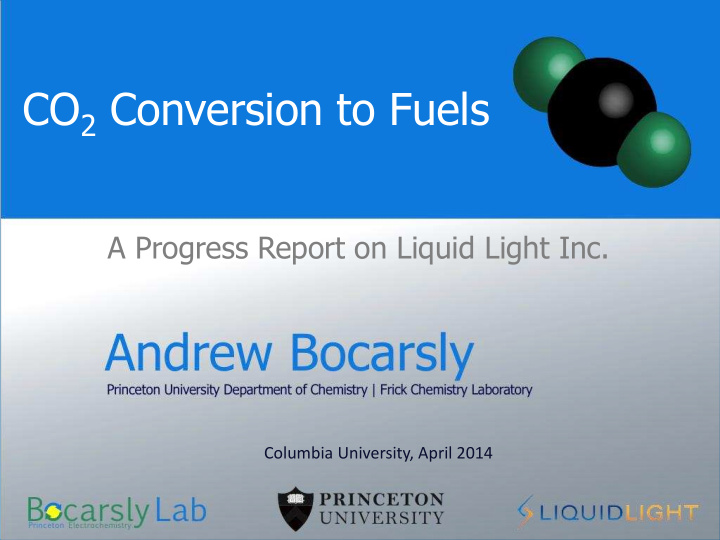



CO 2 Conversion to Fuels A Progress Report on Liquid Light Inc. Columbia University, April 2014
Products and Energetics More More Oxidized Reduced 34 GJ/T 36 GJ/T 36 GJ/T 6 GJ/T Formic Acid Formaldehyde Methanol Syngas 15 GJ/T 33 GJ/T 43 GJ/T 40 GJ/T Oil, Gas Ethanol Ethylene Oxalic Acid Glyoxal CO 2 (CHx) 100 GJ/T Isopropanol 81 GJ/T 100 GJ/T Acetone Propylene 75 GJ/T 2-Butanol
One Cannot Achieve the Electrochemical Energy Goals without an Efficient Catalyst + N H Aromatic Amines Drop the Activation Overpotential to ~200mV
MeOH Evolving PEC Using p-GaP CO 2 + 6e - + 6H + CH 3 OH + H 2 O pH 5.2, 10mM pyridine 96% Faradaic Yield of MeOH @ 200mV UNDERpotential 465nm + N H
CO 2 to Formate at an In Surface
The Liquid Light Process Highlights Renewable Energy Source Abundant cathode materials e - Chemicals & Efficient and e - e - Fuels selective catalysts Product Extraction Low cell voltages CO 2 + xH + 2H 2 O 4H + (energy efficient) + xe - + 4e - + O 2 product Water Stability Waste CO 2 CO 2 Generating Source
Solar Fuel is Here! Solar Panel Provided By and
System Runs Utilize Real Sunlight (AM 1.5) Insolation vs. Cell Response 4/22/13 1200 3.50% 3.00% 1000 Thermionic Efficiency 2.50% Intensity (W/m 2 ) 800 2.00% 600 1.50% 400 1.00% 200 0.50% Cloud Cover 0 0.00% 0.00 20.00 40.00 60.00 80.00 100.00 120.00 Time (minutes)
Liquid Light’s 100cm 2 scale electrochemical cell test bench Cell Controls Test bench Photo shows 100cm2 active area electrochemical cell for conversion of CO2 to multi-carbon product along with test bench used to operate and control electrochemical cell. System includes control of electrolyte feed and circulation and instrumentation for process monitoring and control.
They Did It! Anyone want a good deal on Oxalate?
Acknowledgement Advancing CO 2 Chemistry
A Complex Synergy GaP @ 365nm GaInP 2 @465nm 60 30 Relative Percent Product Relative Percent Product 50 25 Acetone 40 Acetone 20 Methanol Methanol 30 Isopropanol 15 Isopropanol Quantum Yield Quantum Yield 20 10 10 5 0 0 PY1 PY2 PY3 PY4 PY5 PY2 PY3 PY4 PY5 PY6 Catalyst Catalyst
p-GaP MeOH Evolving Cell CO 2 + 6e - + 6H + CH 3 OH + H 2 O pH 5.2, 10mM pyridine 465nm
Formic Acid System Scale-Up Currently producing target chemicals at grams/day with product concentration streams > 3% and CD > 100 mA/cm 2 and 1000 hr stability testing, now scaling up to kg/day over the next year
What should we do with CO 2 ? Schematic diagram of possible CCS systems Sequestration SRCCS Figure TS-1 93% Fuels CO 2 Utilization 7% Utilization: Polymers, Solid-State Products
Carbon-Carbon Coupling is Possible! GaP @ 365nm 60 Relative Percent Product 50 Acetone 40 Methanol 30 Isopropanol Quantum Yield 20 10 0 PY2 PY3 PY4 PY5 PY6 Catalyst
Counting the Cost If 1 Mole of CO 2 is converted: According to the US DOE a CO 2 reduction kinetics gas fired power plant generates 0.57 Moles CO 2 1135 pounds of CO 2 /MWH 3.0eV ≥170kJ/mole (1.4V) photon 2.82 Moles CO 2 H 2 O O 2 kinetics – 1.00 Moles Consumed (0.4V) 1.82 Moles Net Formed! CH 3 OH + 3/2O 2 2.25 Moles CO 2 1.6eV 6e - /6H + 690kJ/mole (1.2V•6e -) CO 2 + 2H 2 O
Recommend
More recommend